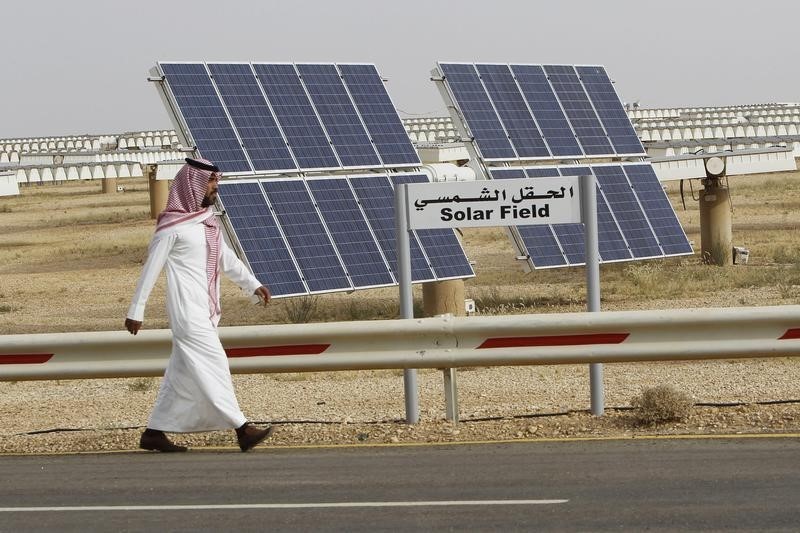By Andrew Torchia
DUBAI (Reuters) - The cost of insuring Saudi Arabia's debt against default has risen since the kingdom announced a plan to wean itself off volatile oil exports, showing that some investors fear it won't be able to raise enough revenue to make the reforms work.
The blueprint, unveiled two weeks ago, includes creating the world's largest sovereign wealth fund, selling state assets and, with prospects for an end to the oil slump uncertain, shifting responsibility for growth to the non-oil private sector.
Deputy Crown Prince Mohammed bin Salman, author of the Vision 2030 program, said that, by 2020, "we can live without oil".
The need is pressing. Last year's budget deficit was 367 billion riyals ($98 billion), or 15 per cent of GDP, a level that Riyadh could probably only sustain for another two or three years before financial markets became alarmed.
But the plan requires tens of billions of dollars of fresh revenue from the private sector, not only to shore up the state budget but also to pay for the government's share of development projects.
The price of five-year Saudi credit default swaps <SAGV5YUSAC=MG> suggests that financial markets think that's a big ask. It has risen to 155 points in the past two weeks from 145, implying a 10 percent chance of a sovereign default over the next five years, making Saudi Arabia a riskier proposition than the Philippines or Thailand.
"The core challenge around the Vision and the Saudi economy is fiscal sustainability," said Steffen Hertog, economist at London School of Economics and author of a book on the Saudi bureaucracy.
He said the tax potential of the private sector was much smaller than the state’s spending needs, and increasing that potential would be hard since businesses depended on government contracts and on consumer demand fed by state salaries.
The planned sale of some government assets, including up to 5 percent of oil giant Saudi Aramco, may plug part of the budget deficit until the private sector can pay more taxes.
But since Saudi capital markets are small, the asset sales will require a leap in foreign inflows at a time when low oil prices are causing unease among investors.
REVENUES
The plan envisages boosting the government's annual non-oil revenues to at least 500 billion riyals ($133 billion) by 2020 -- a figure of 600 billion has also been mentioned -- and to 1 trillion riyals by 2030.
That would be a big jump from 163.5 billion riyals last year. Assuming oil revenues rebound to their 2015 level by 2020, the government would be getting 53 percent of its income from non-oil sources that year, compared to 27 percent last year.
Non-oil revenues surged 29 percent last year, the finance ministry said. But the increase was almost entirely due to income from investments and unspecified "other revenues" - sources that the government cannot expect to soar indefinitely.
Riyadh says it will boost returns from its investments by managing its funds more aggressively. But the current global environment will not make that easy.
"They’re not going to get major returns around the world because nobody is getting major returns around the world,” said Shanker Singham, chief executive of consultancy Competere Group.
That leaves a raft of new measures billed as boosting non-oil revenues by nearly $100 billion over the next five years.
Prince Mohammed has said cutting energy subsidies and letting domestic fuel and utility prices rise, a process that has already begun, could generate $30 billion by 2020.
But he said big changes would not occur until Riyadh had introduced a scheme to compensate the poorest 30 percent for the blow to their incomes. That could limit the net savings from subsidy cuts, perhaps to around $20 billion.
A further $10 billion is due to come from introducing a value-added tax in 2018, which estimates by the International Monetary Fund suggest is feasible.
The impact of other measures looks more uncertain.
There are about currently 10 million foreigners in Saudi Arabia, most in low-paying service or construction jobs. Riyadh says it can raise $10 billion a year from a charge on firms that hire more foreign workers, and another $10 billion from a scheme to sell long-term residency rights to foreigners.
A total of $40 billion annually is to come from "other measures". Most of that may be privatization proceeds; Prince Mohammed estimated Aramco was worth over $2 trillion, so a one-off sale of 5 percent could theoretically bring in $100 billion, or $20 billion a year over five years. But with oil currently so cheap, the size of any privatization is uncertain.
A new tax on undeveloped land is expected to raise several billion dollars, and taxes on luxury items, tobacco and sugary drinks will bring more revenue.
OPTIONS
If the non-oil revenue push falls short, Riyadh may still be able to escape fiscal crisis. A rebound of the average annual Brent oil price to, say, $60 a barrel from last year's $53.60 would add several billion dollars to revenues.
If necessary, Riyadh could draw down foreign assets more quickly - though that would risk unsettling markets - or cut spending more sharply, though that would slow the economy and make it harder to encourage private investment.
But the investment bank Credit Suisse (SIX:CSGN) said the Saudi reform plan should not be judged by whether it met all its targets.
"Even if half of all the targets are reached, we believe it would yield significant improvements in the structure of the Saudi economy," it said.
